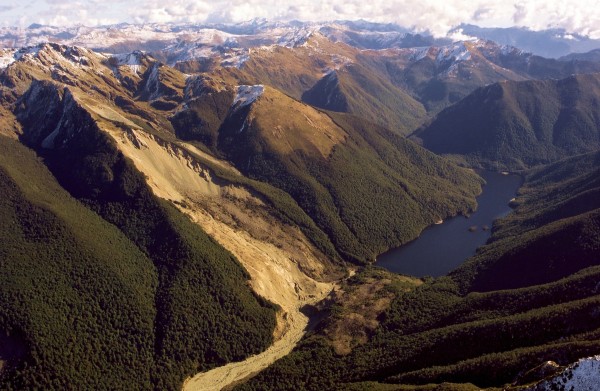Past Earthquakes Play a Role in Future Landslides, Research Suggests

G. Hancox, GNS Science (New Zealand). The image is of the Lake Stanley rock avalanche, which was the largest landslide triggered by the 1929 earthquake. The lake in the image was dammed by the landslide.
The likelihood of an area experiencing a potentially devastating landslide could be influenced by its previous exposure to earthquakes many decades earlier.
This is according to new research led by Cardiff University showing that areas which have experienced strong earthquakes in the past were more likely to produce landslides when a second earthquake hit later on.
Researchers speculate that this is because damage can reside in the side of mountains after an initial earthquake, and that the consequences of this damage may only be felt when a second earthquake hits.
These new insights could have important implications for disaster management and prevention by helping researchers better predict areas that may be susceptible to future landslides.
The consequences of the landslides that occurred after two large earthquakes hit Nepal earlier this year, killing more than 9,000 people and inflicting wide-spread damage, serves to show how valuable a prediction tool would be.
Predictive models that are currently used to assess the likelihood of landslides do not consider historical occurrences of previous earthquakes, and instead focus on the strength of the earthquake and the characteristics of the particular area, including the make-up of rock and the steepness of slopes.
“This could potentially be a significant gap in our understanding of the factors that lead to landsliding,” said Dr Robert Parker, lead author of the paper, from Cardiff University’ School of Earth and Ocean Sciences.
After the Nepal earthquakes, a program called ShakeSlide, developed by Dr Parker, was used to predict areas affected by landslides and assist in post-disaster efforts.
These new findings may lead to improved predictions, through models that consider the legacy of past earthquakes.
To reach their conclusions, the research team analysed data from two individual earthquakes that occurred in close-proximity to each other, in 1929 and 1968, on the South Island of New Zealand.
The epicentres of the two earthquakes were around 21 km apart and both triggered landslides over a large area.
The researchers firstly analysed the influence that standard factors, such as the strength of the earthquake and the gradient of hillslopes, had on the distribution of landslides.
Where the results were unexplained by these standard factors, the researchers investigated whether the results could be attributed to the legacy of previous events.
Their results suggested that hillslopes in regions that experienced strong ground motions in the 1929 earthquake were more likely to fail during the 1968 earthquake than would be expected on the basis of the standard factors alone.
“Our results suggest that areas that experienced strong shaking in the first earthquake were more likely to produce landslides in the second earthquake than would be expected based on the strength of shaking and hillslope characteristics alone,” said Dr Parker.
Dr Parker and his team have speculated that the increased likelihood of occurrence may be down to the fact that damage persists in the landscape after an initial earthquake, making it sufficiently weaker and thus more prone to a landslide if another earthquake hits in the future.
Dr Parker continued: “Strong shaking in a past earthquake may actually cause mountains to be more hazardous, in terms of landslides, in a future earthquake many years or decades later. You could think of it as mountains remembering past earthquakes, which affects how they respond to future earthquakes.”
Dr Parker and his team are now investigating whether this ‘memory effect’ is seen in other areas, and have begun investigating the earthquakes that occurred in Nepal.
The new study has been published in the journal Earth Surface Dynamics.
ENDS
Notes to editors
1. For further information contact:
Michael Bishop
Communications & Marketing
Cardiff University
Tel: 02920 874499
Email: BishopM1@cardiff.ac.uk
2. Cardiff University is recognised in independent government assessments as one of Britain’s leading teaching and research universities and is a member of the Russell Group of the UK’s most research intensive universities. The 2014 Research Excellence Framework ranked the University 5th in the UK for research excellence. Among its academic staff are two Nobel Laureates, including the winner of the 2007 Nobel Prize for Medicine, University Chancellor Professor Sir Martin Evans. Founded by Royal Charter in 1883, today the University combines impressive modern facilities and a dynamic approach to teaching and research. The University’s breadth of expertise encompasses: the College of Arts, Humanities and Social Sciences; the College of Biomedical and Life Sciences; and the College of Physical Sciences and Engineering, along with a longstanding commitment to lifelong learning. Cardiff’s flagship Research Institutes are offering radical new approaches to pressing global problems. www.cardiff.ac.uk
Contact Information
Mike Bishop
Senior Communications Officer
BishopM1@cardiff.ac.uk
Media Contact
All latest news from the category: Earth Sciences
Earth Sciences (also referred to as Geosciences), which deals with basic issues surrounding our planet, plays a vital role in the area of energy and raw materials supply.
Earth Sciences comprises subjects such as geology, geography, geological informatics, paleontology, mineralogy, petrography, crystallography, geophysics, geodesy, glaciology, cartography, photogrammetry, meteorology and seismology, early-warning systems, earthquake research and polar research.
Newest articles

Peptides on Interstellar Ice
A research team led by Dr Serge Krasnokutski from the Astrophysics Laboratory at the Max Planck Institute for Astronomy at the University of Jena had already demonstrated that simple peptides…

A new look at the consequences of light pollution
GAME 2024 begins its experiments in eight countries. Can artificial light at night harm marine algae and impair their important functions for coastal ecosystems? This year’s project of the training…

Silicon Carbide Innovation Alliance to drive industrial-scale semiconductor work
Known for its ability to withstand extreme environments and high voltages, silicon carbide (SiC) is a semiconducting material made up of silicon and carbon atoms arranged into crystals that is…




















